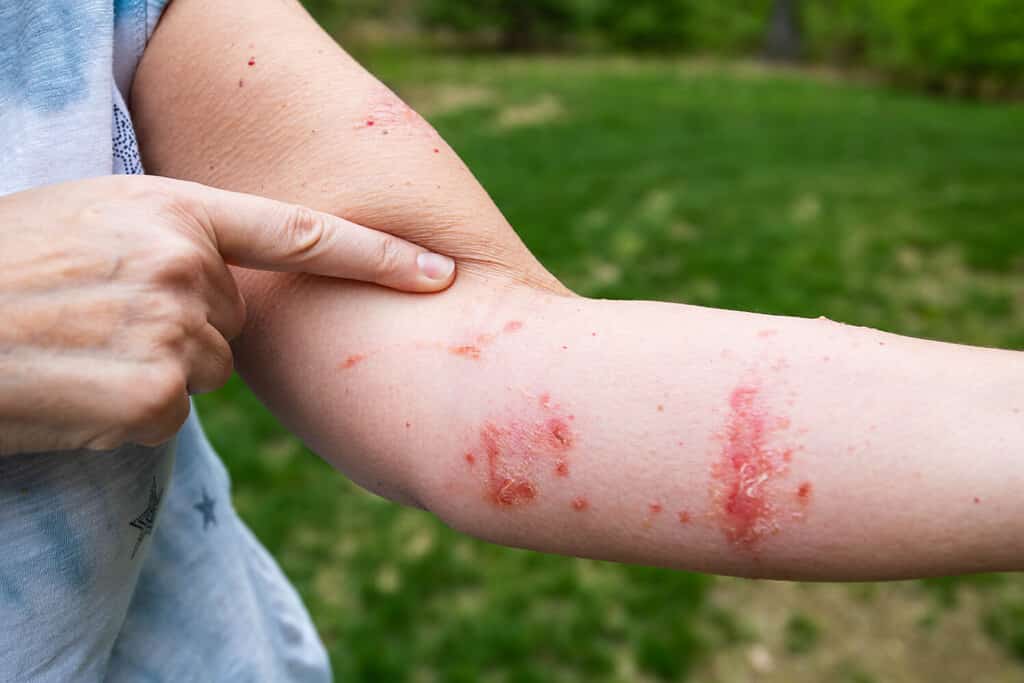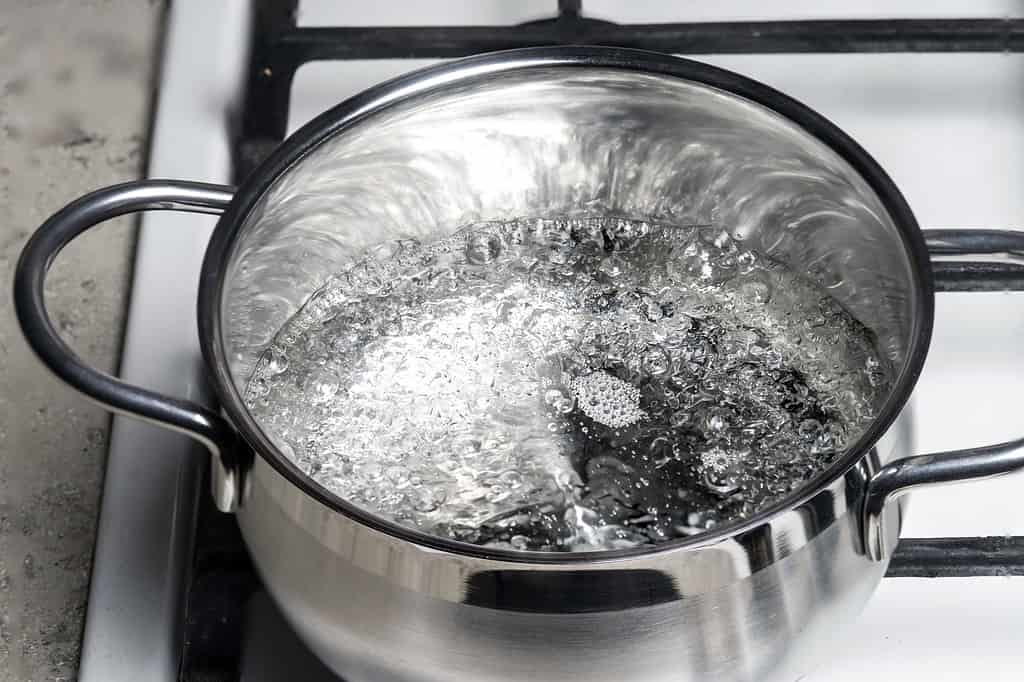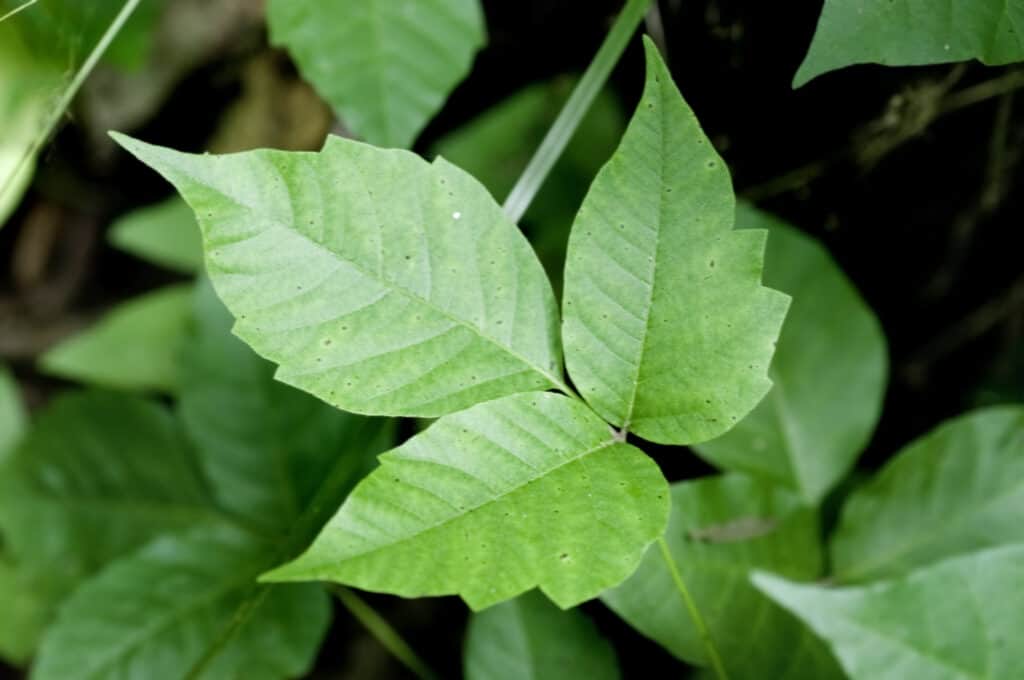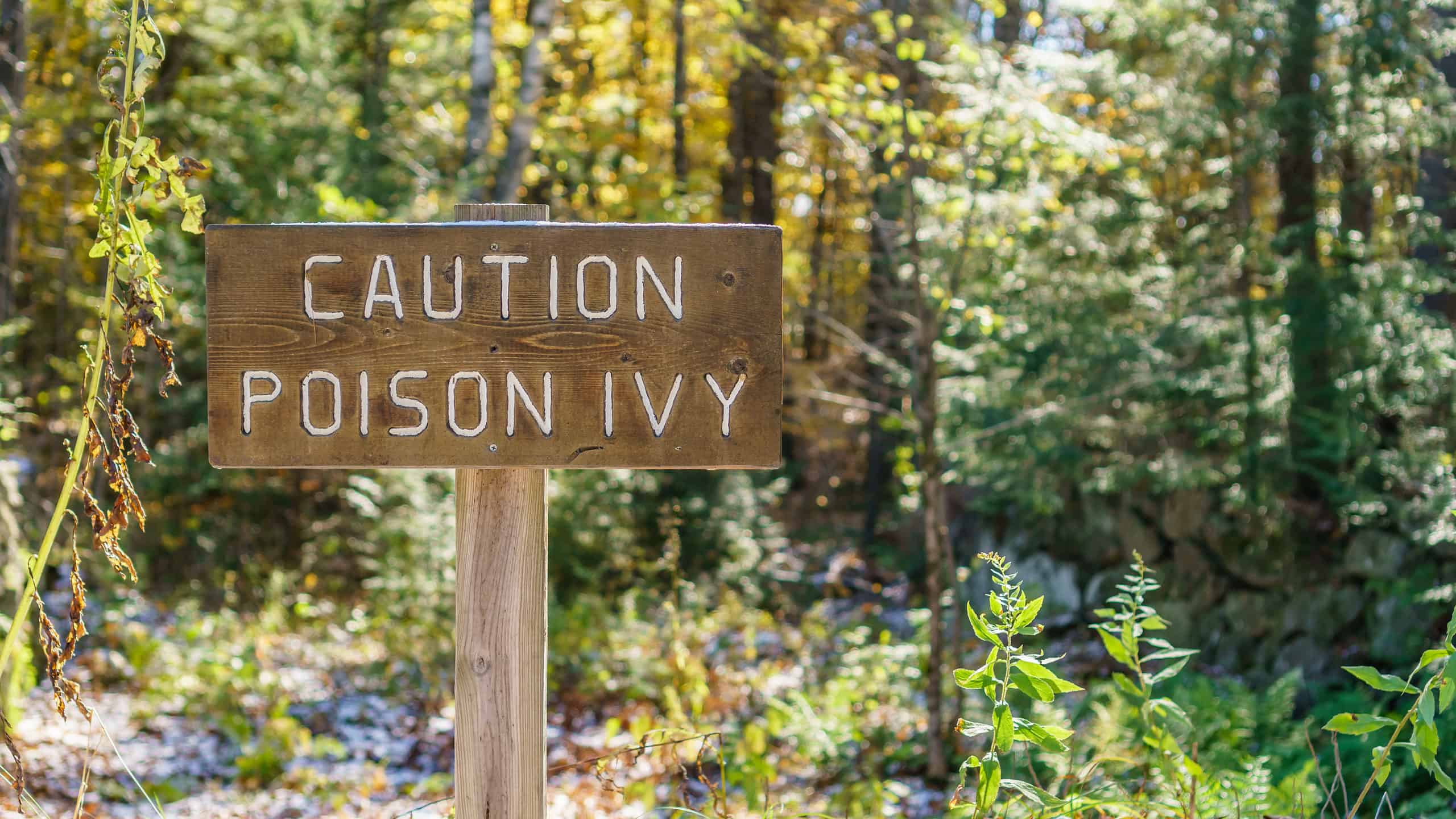Tired of battling those pesky poison ivy plants in your yard? You’re not alone! Poison ivy, with its notorious three-leafed clusters, can cause an itchy nightmare. But fear not, because, in this article, we’ll dive into the best ways to kill poison ivy troublemakers in your outdoor space.
1. Manual Removal
Poison ivy is a pesky plant that many people encounter in gardens, woodlands, and fields. It’s infamous for its itchy, bothersome rash. If you find it in your yard, one effective method to get rid of it is through manual removal.
Before starting, it’s essential to be able to identify the plant accurately. Poison ivy typically has three pointed leaflets, but its appearance can vary. The saying “leaves of three, let it be” is a helpful reminder. It can grow as a low shrub or as a climbing vine. In the fall, its leaves might turn red or purple.
It’s a good idea to use disposable plastic bags as glove extensions to ensure the plant doesn’t touch any part of your arm. Remember, even dead poison ivy can cause a rash, so always be cautious.
Start by using a shovel or hand pruner to cut the plant at its base. If the plant is a vine, be sure to cut it away from any trees or structures it might be climbing. After cutting, carefully dig around the base of the plant to expose its roots. Grasp the base and pull the plant out, ensuring you remove as much of the root system as possible. The goal is to prevent it from regrowing. Place the removed plant into a plastic bag, seal it, and dispose of it. Don’t compost it, as the urushiol oil, which causes the allergic reaction, can remain active for several years.
After removal, clean your tools and gloves with rubbing alcohol or soap and lots of water. Wash the clothes you were wearing separately from other laundry. It’s crucial to minimize the chance of spreading the plant’s oil. Lastly, if you think you’ve been exposed, shower immediately and scrub your skin with plenty of soap.

It’s vital to use precautions during manual removal, as not being protected can cause serious rashes.
©Michael Moloney/Shutterstock.com
2. Glyphosate
Glyphosate is an effective method for eliminating poison ivy, a noxious plant known for causing itchy rashes upon contact. Poison ivy contains a resilient oil called urushiol that triggers skin irritation in most people. When dealing with a poison ivy infestation, it is crucial to eradicate the plant thoroughly.
The broad-spectrum herbicide glyphosate is frequently used in commercial goods like Roundup. It functions by preventing an enzyme necessary for plant development, which ultimately results in the plant wilting and dying. Because glyphosate is non-selective, if it is not used appropriately, it may kill nearby plants as well.
The first step in using glyphosate to treat poison ivy is locating and isolating the affected area. If you want to avoid coming into touch with the oil from poison ivy, wear protective clothes such as gloves, long sleeves, and eye protection. Mix the glyphosate concentrate according to the product label instructions. Typically, a 2% to 5% glyphosate solution is suitable for poison ivy control.
Apply the glyphosate solution directly to the leaves and stems of the poison ivy plant, ensuring complete coverage. It is best to apply glyphosate when the poison ivy is actively growing during the spring or early summer. Be cautious not to spray on desirable plants nearby, as glyphosate can harm them as well.
After treatment, give the glyphosate some time, usually two weeks, to go through the poison ivy’s system. The herbicide’s effects will eventually cause the plant to wilt and yellow, which will cause symptoms to appear gradually. You may gently remove and dispose of the poison ivy when it has died, being sure to keep away from any touch with the plant’s remnants.
When using glyphosate or any other herbicide, keep in mind to always abide by safety precautions and product directions. Poison ivy is thought to be well-addicted by glyphosate, although it should be used cautiously to reduce any negative effects on the environment and safeguard non-target plants.
3. Triclopyr
Triclopyr is another approach for getting rid of poison ivy that works well. Herbicide triclopyr has shown to be very effective in getting rid of this problematic plant.
First and foremost, it’s crucial to realize that poison ivy is a hardy and persistent plant that, if not properly treated, may swiftly spread. Triclopyr acts by interfering with the development and metabolism of the plant, ultimately causing its demise. Unlike some other herbicides, triclopyr targets the specific characteristics of poison ivy, making it a highly targeted and effective solution.
To apply triclopyr, you should first identify the poison ivy plants you want to eliminate. This can be done by recognizing the distinctive three-leaf pattern of poison ivy. Once identified, carefully apply the triclopyr solution to the leaves and stems of the plant. It’s crucial to follow the manufacturer’s instructions on the product label for the correct dilution and application method.
Triclopyr is selective in its action, which means it primarily affects the target plant, in this case, poison ivy while sparing other desirable plants nearby. This makes it a preferred choice for many gardeners and homeowners.
It’s important to remember that utilizing triclopyr to get rid of poison ivy requires patience. It may take a few weeks before the poison ivy starts to show indications of deterioration, so results might not be apparent right away. If the infestation is severe, several sprays could be required to entirely remove the plant.
4. Boiling Water
Boiling water can be an effective method for eliminating poison ivy, a troublesome plant known for causing painful skin rashes upon contact. While it’s essential to emphasize the importance of correctly identifying poison ivy before attempting any removal, boiling water offers several advantages as a treatment option.
One key reason boiling water works well is its simplicity. It’s a readily available resource in most households, making it a convenient choice for poison ivy removal. Unlike chemical herbicides or specialized tools, boiling water doesn’t require any additional purchases or equipment. This accessibility means that anyone can use it to address a poison ivy problem promptly.
Moreover, boiling water is a natural and environmentally friendly solution. It avoids the usage of potentially dangerous chemicals that can seep into the soil and disrupt the environment in the area. This environmentally friendly strategy is especially important in gardens or other natural settings where poison ivy may be a serious problem.
The capacity of boiling water to burn and destroy a plant’s root system accounts for its efficacy. The high temperature of the water causes the plant cells to break when it is immediately poured over the poison ivy plant, thereby killing the plant. Unlike milder treatments, such as pulling or cutting, which may leave behind roots capable of regenerating, boiling water can penetrate deep into the soil to eradicate the entire plant.
Additionally, using boiling water for poison ivy removal minimizes the risk of direct contact with the plant, reducing the chance of skin irritation or allergic reactions. It also eliminates the need for physical contact with potentially contaminated tools or gloves, further decreasing the risk of spreading the irritating oils from poison ivy.

Boiling water is a good treatment to try if you have just a small amount of poison ivy plants in your yard.
©VladK213/iStock / Getty Images Plus via Getty Images
5. Smothering
Smothering stands out as yet another highly effective and environmentally friendly technique for getting rid of poison ivy plants. This method involves covering the plant completely so it’s deprived of sunlight, essentially “choking” it out of existence.
The principle behind smothering is simple: all plants, including poison ivy, need sunlight for photosynthesis. This process allows plants to convert light into energy, fueling their growth. When you smother poison ivy, you block its access to sunlight. Without light, the plant can’t produce energy and, over time, it weakens and eventually dies.
Begin by mowing or cutting the plant down to the ground, and wearing protective clothing to prevent skin contact. Next, lay down a thick layer of newspaper or cardboard over the area where the poison ivy is growing. Ensure that you overlap the edges by several inches to prevent the plant from finding any gap to grow through. Once this is done, cover the newspaper or cardboard with a three to four-inch layer of mulch.
Over time, the poison ivy beneath this smothering layer will be starved of sunlight and die. It’s important to keep an eye on the area and add more mulch or paper as needed, especially if you see any poison ivy trying to peek through.
6. Prevention
Prevention is often the most effective approach to dealing with poison ivy. This approach hinges on avoiding contact with the plant altogether, reducing the risk of exposure and the need for subsequent treatment. Understanding the characteristics of poison ivy is essential, even though we won’t delve into identification here, as recognizing it can help you steer clear of it.
First and foremost, it’s essential to wear protective, high-coverage clothing when walking into areas where poison ivy may be present. Long sleeves, pants, and closed-toe shoes create a barrier between your skin and the plant’s oils, minimizing the chances of a rash. Additionally, wearing gloves can be particularly helpful if you plan on handling plants or clearing foliage in potentially contaminated areas.
Frequent handwashing is another key element of prevention. Poison ivy’s oils can linger on your skin, clothing, and even pets. By thoroughly washing your hands and any clothing that may have come into contact with poison ivy, you can remove the oils before they have a chance to cause a rash.
In some cases, applying a barrier cream, like a lotion containing bentoquatum, before venturing into wooded or overgrown areas can provide an extra layer of protection. These creams create a barrier on the skin, preventing the plant’s oils from directly contacting your skin.
Lastly, if you suspect you’ve been exposed to poison ivy, it’s crucial to act promptly. Rinse the affected area with cool water within 30 minutes of contact. This can help wash away some of the oils and reduce the severity of the rash. Be sure to clean any clothing or tools that may have touched the plant as well.
7. Proper Disposal
If you have this bothersome plant on your property, you might be tempted to pull it out bare-handed or mow it down. However, such methods can spread the oils and make the problem worse. One of the best ways to tackle this problem is through proper disposal.
To effectively remove poison ivy, you must be careful. Before you start, it’s essential to wear protective gear, including gloves, long sleeves, and long pants, to prevent any contact with the skin. Using garden tools, gently dig around the roots to ensure you get the entire plant out. Remember, even dead plants can still have urushiol oil, so always be cautious.
Once you’ve uprooted the poison ivy, never compost it or throw it in with your regular garden waste. The oil can remain potent for years, and you don’t want to risk spreading it or having someone unknowingly come into contact with it. The safest way to dispose of poison ivy is to put it in a plastic bag, seal it tightly, and throw it in the trash.
If you burn poison ivy, be extremely careful. Burning can release the urushiol oil into the air, and inhaling it can cause severe respiratory problems. If you must burn it, do so in an open area, stay upwind, and ensure no one else is around. However, the safest method remains bagging and trashing.
The key to getting rid of poison ivy is understanding that it’s not just about removing the plant, but about handling and disposing of it safely. Proper disposal ensures that the problematic urushiol oil doesn’t spread or remain a hidden threat in your environment. By being careful and following these steps, you can effectively and safely rid your property of poison ivy.

Prevention and proper disposal are key when it comes to getting rid of poison ivy.
©Tim Mainiero/Shutterstock.com
8. Professional Removal
When all else fails, you can always count on a pro to tackle the task of poison ivy removal. While many might consider tackling the removal of this plant themselves (and any of the methods in this guide could work), a far safer and more effective solution is to opt for professional removal.
One of the primary reasons to choose professional removal is the expertise that comes with it. Professionals have the knowledge and experience to handle poison ivy safely. Their thorough approach prevents the poison ivy from growing back, providing a long-term solution.
Additionally, the professionals come equipped with the right tools and protective gear. The specific tools they use help them to uproot the plant without causing it to break and release more of its harmful oil. This is particularly essential since even a small amount of urushiol can cause rashes. Their protective equipment shields them from coming into direct contact with the plant, minimizing any risks. This level of protection might be challenging to achieve with standard home gardening gear.
Another great thing about professional removal is the disposal process. Once the poison ivy is uprooted, it needs to be disposed of safely to ensure that its harmful effects don’t linger. Professionals know exactly how to do this.
While it might seem tempting to handle poison ivy on your own, the risks associated with doing so make it a task best left to the professionals. Their expertise, tools, and disposal methods make the process smooth, efficient, and safe. You can always try other methods beforehand to see if they will work, provided you do so with the right safety precautions. But if those pesky plants keep coming back, a pro can help!
Summary of Effective Solutions That Kill Poison Ivy Permanently
| # | Solution |
|---|---|
| 1 | Manual Removal |
| 2 | Glyphosate |
| 3 | Triclopyr |
| 4 | Boiling Water |
| 5 | Smothering |
| 6 | Prevention |
| 7 | Proper Disposal |
| 8 | Professional Removal |
Thank you for reading! Have some feedback for us? Contact the AZ Animals editorial team.








